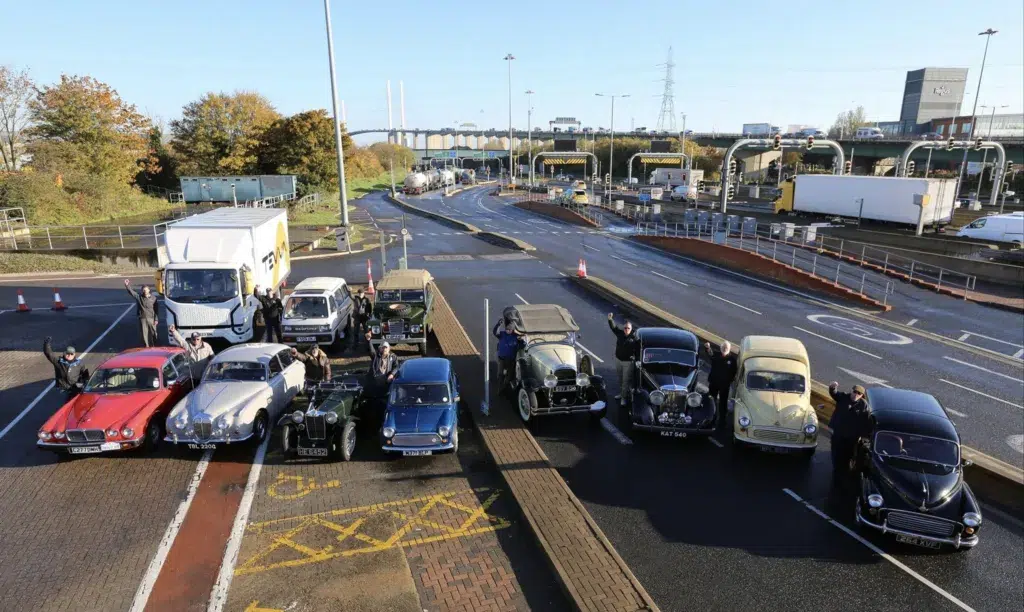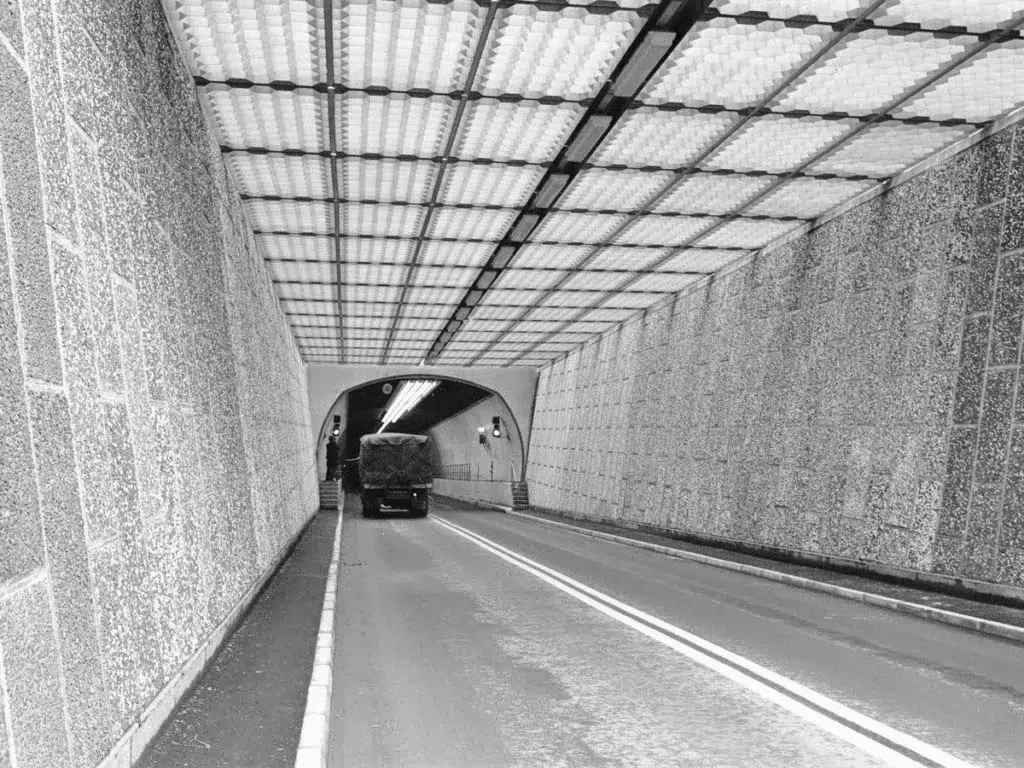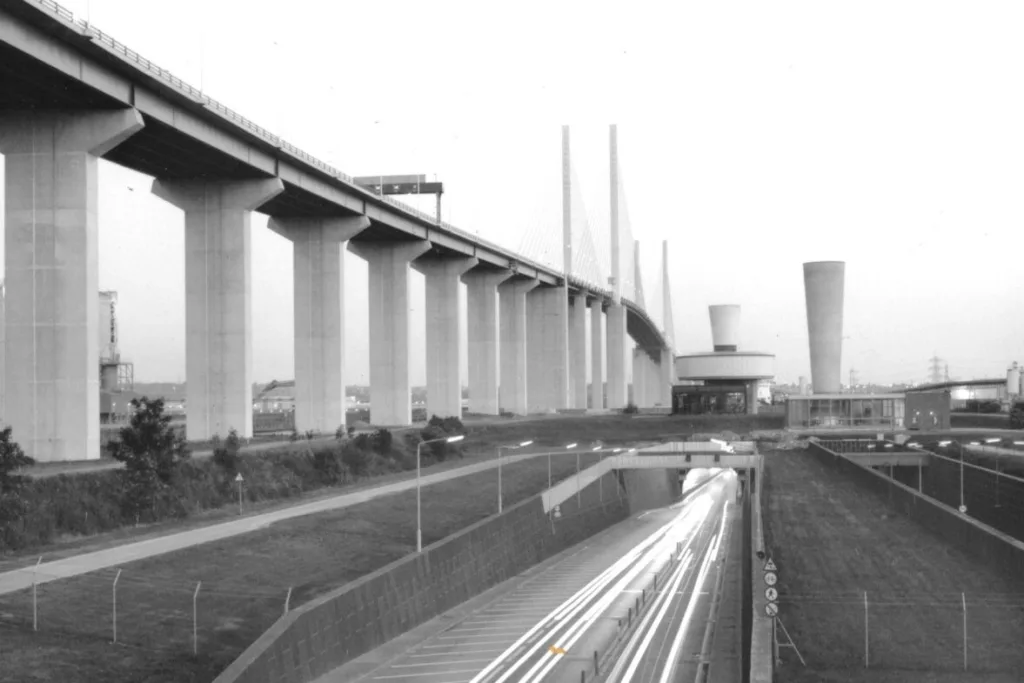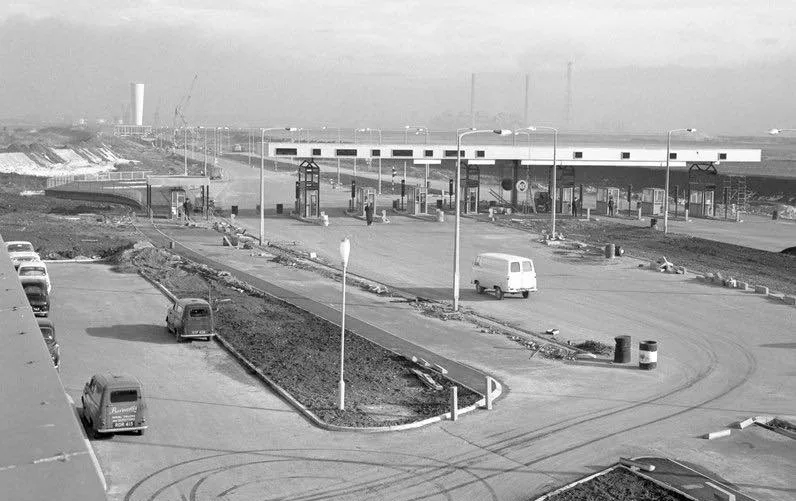The Dartford Crossing celebrated its 60th birthday on Saturday (18 Nov), and a vintage car parade and historical images found in the archive of Dartford Crossing have been released by National Highways.
Ten cars from the South Eastern Vintage and Classic Vehicle Club in Essex took part in the parade, with cars dating back as far as the 1930s, when construction on the Dartford Crossing first started. A Hydrogen Electric HGV from Tilbury-based Tevva led the procession, representing the fuels and vehicles of the future. Cars included a Buick Series 40 Phaeton and an MG PA (midget) from the 1930s and a 35th Anniversary Edition Mini from the 1990s. The parade was waved off into the tunnel by Cllr Jeremey Kite, Leader of Dartford Borough Council.
The Dartford Crossing is the only road across the River Thames east of London. Prior to its opening on 18 November 1963, anyone wanting to travel between Kent and Essex had to take a ferry or use the Blackwall tunnel. Today it is one of the UK’s most important transport routes, that carries over 50 million vehicles a year between some of the country’s biggest ports and distribution hubs. Over 40% of vehicles travelling on it carry goods – a higher percentage than any other road on the strategic road network.

Speaking about the importance of the Dartford Crossing, Francis Cluett, Head of Delivery in National Highways, said:
Advertisement
“It is important to celebrate the 60th anniversary of the first tunnel. It was an amazing engineering achievement at the time and had a huge impact on the communities either side of the Thames.”
“Before it opened, the only means of crossing was by ferries – the tunnel has provided vital connections between people, jobs, and businesses for 60 years. Huge numbers of people have contributed over that time in planning, building, managing and maintaining the tunnel and it is time to recognize their achievement.”
“We are working hard to ensure that the tunnel and other parts of the Dartford Crossing remain safe and operational for years to come.”
Over the last 60 years the Dartford Crossing has played a vital role in bringing prosperity to the region, bringing new opportunities and jobs within reach of those living in Kent and Essex.
The idea of a tunnel connecting Kent and Essex was first conceived in 1926. Works started in the 1930s but were paused due to World War II. Construction resumed in 1959, with the first, western tunnel opening in 1963. Initially only 12,000 vehicles per day used the crossing, in stark contrast to today with more than 150,000 using the route on an average day and 180,000 on its busiest days.
Over the past 60 years the volume and type of traffic using the route is unrecognisable. In 1963 the most popular car was the Austin Morris 1100, which was a fraction of the size, weight and power of modern cars. Today’s HGVs are significantly longer, taller, and heavier than the goods vehicles of the day and the Dartford Crossing now has to contend with 10,000 abnormal loads each year. This change in vehicles and volumes means there is a huge daily effort to keep traffic moving, while also maintaining the structure to ensure it can cope with modern day demands.

Regarding the issue of Heavy Goods Vehicles (HGVs), Stuart Cottrell, Head of Energy Services and Government Partnerships at Tevva, said:
“Tevva is on a mission to decarbonise trucking, developing a range of battery-electric and hydrogen-electric medium-duty trucks that reduce emissions, improve air quality and eliminate range anxiety. As a close neighbour of the Lower Thames Crossing, we can’t wait to see our trucks on the new road connecting Essex and Kent, helping the movement of goods in the quickest and most efficient ways possible.”
Advertisement
Initially designed for around two million vehicles annually, the Dartford Crossing quickly surpassed expectations, handling over eight million vehicles yearly by 1970. In response, an additional tunnel was constructed and opened in 1980, accommodating traffic in both directions. The completion of the M25 further increased demand, leading to another expansion, culminating in the opening of the Queen Elizabeth Bridge in 1991.

Cllr Jeremy Kite, Leader of Dartford Borough Council said:
“Since the opening of the first tunnel sixty years ago the Crossings has been an everyday part of the lives of local people.”
“Today, as vehicle sizes and traffic volumes increase, Britain needs to show similar vision and get on with a new Thames crossing east of Dartford to relieve the pressure here and put the region’s economic potential back on track. Sixty years ago, opportunities to create crossings with the environmental features to make them cleaner and greener were far less than we have today. It’s time to get things started safe in the knowledge that we are doing the right thing for future generations.”
“The same vision and determination which led to first crossing the Thames at Dartford 60 years ago is needed again now to create the modern Lower Thames Crossing “.
The Dartford Crossing has one of the largest specialist traffic management teams of its kind dedicated to keeping it moving 24/7. National Highways is proposing the construction of a new road and tunnel, the Lower Thames Crossing, to almost double road capacity across the Thames east of London, to safeguard the resilience of the region’s road network.
The detailed examination of the Lower Thames Crossing by the Government’s independent planning experts is underway and if plans are approved, construction is currently expected to start in 2026.
To find out more about the improvement work on the Lower Thames Crossing, visit the webpage: Lower Thames Crossing – National Highways
Advertisement














